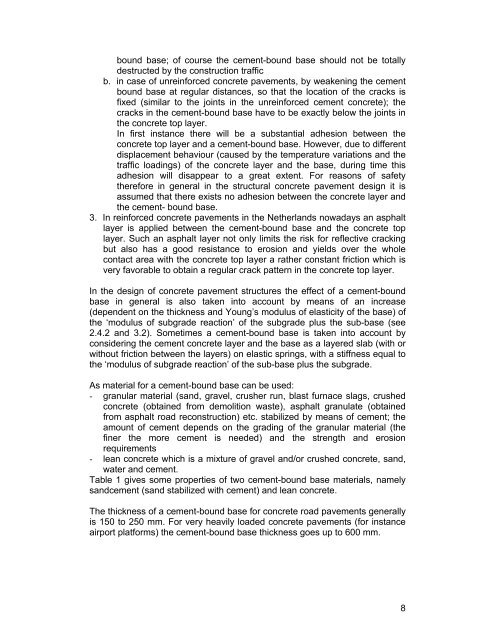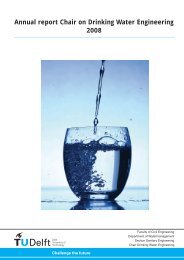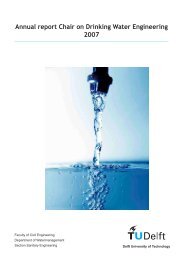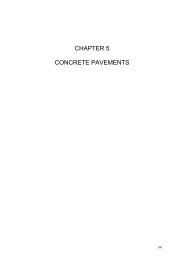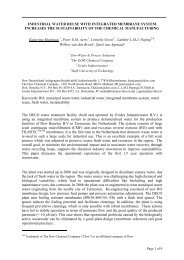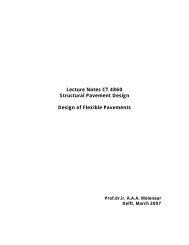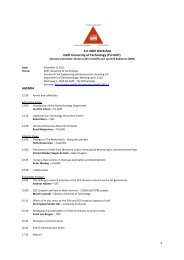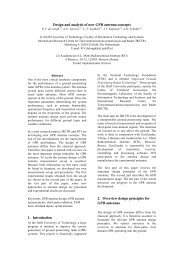CT4860 STRUCTURAL DESIGN OF PAVEMENTS
CT4860 STRUCTURAL DESIGN OF PAVEMENTS
CT4860 STRUCTURAL DESIGN OF PAVEMENTS
You also want an ePaper? Increase the reach of your titles
YUMPU automatically turns print PDFs into web optimized ePapers that Google loves.
ound base; of course the cement-bound base should not be totally<br />
destructed by the construction traffic<br />
b. in case of unreinforced concrete pavements, by weakening the cement<br />
bound base at regular distances, so that the location of the cracks is<br />
fixed (similar to the joints in the unreinforced cement concrete); the<br />
cracks in the cement-bound base have to be exactly below the joints in<br />
the concrete top layer.<br />
In first instance there will be a substantial adhesion between the<br />
concrete top layer and a cement-bound base. However, due to different<br />
displacement behaviour (caused by the temperature variations and the<br />
traffic loadings) of the concrete layer and the base, during time this<br />
adhesion will disappear to a great extent. For reasons of safety<br />
therefore in general in the structural concrete pavement design it is<br />
assumed that there exists no adhesion between the concrete layer and<br />
the cement- bound base.<br />
3. In reinforced concrete pavements in the Netherlands nowadays an asphalt<br />
layer is applied between the cement-bound base and the concrete top<br />
layer. Such an asphalt layer not only limits the risk for reflective cracking<br />
but also has a good resistance to erosion and yields over the whole<br />
contact area with the concrete top layer a rather constant friction which is<br />
very favorable to obtain a regular crack pattern in the concrete top layer.<br />
In the design of concrete pavement structures the effect of a cement-bound<br />
base in general is also taken into account by means of an increase<br />
(dependent on the thickness and Young’s modulus of elasticity of the base) of<br />
the ‘modulus of subgrade reaction’ of the subgrade plus the sub-base (see<br />
2.4.2 and 3.2). Sometimes a cement-bound base is taken into account by<br />
considering the cement concrete layer and the base as a layered slab (with or<br />
without friction between the layers) on elastic springs, with a stiffness equal to<br />
the ‘modulus of subgrade reaction’ of the sub-base plus the subgrade.<br />
As material for a cement-bound base can be used:<br />
- granular material (sand, gravel, crusher run, blast furnace slags, crushed<br />
concrete (obtained from demolition waste), asphalt granulate (obtained<br />
from asphalt road reconstruction) etc. stabilized by means of cement; the<br />
amount of cement depends on the grading of the granular material (the<br />
finer the more cement is needed) and the strength and erosion<br />
requirements<br />
- lean concrete which is a mixture of gravel and/or crushed concrete, sand,<br />
water and cement.<br />
Table 1 gives some properties of two cement-bound base materials, namely<br />
sandcement (sand stabilized with cement) and lean concrete.<br />
The thickness of a cement-bound base for concrete road pavements generally<br />
is 150 to 250 mm. For very heavily loaded concrete pavements (for instance<br />
airport platforms) the cement-bound base thickness goes up to 600 mm.<br />
8


